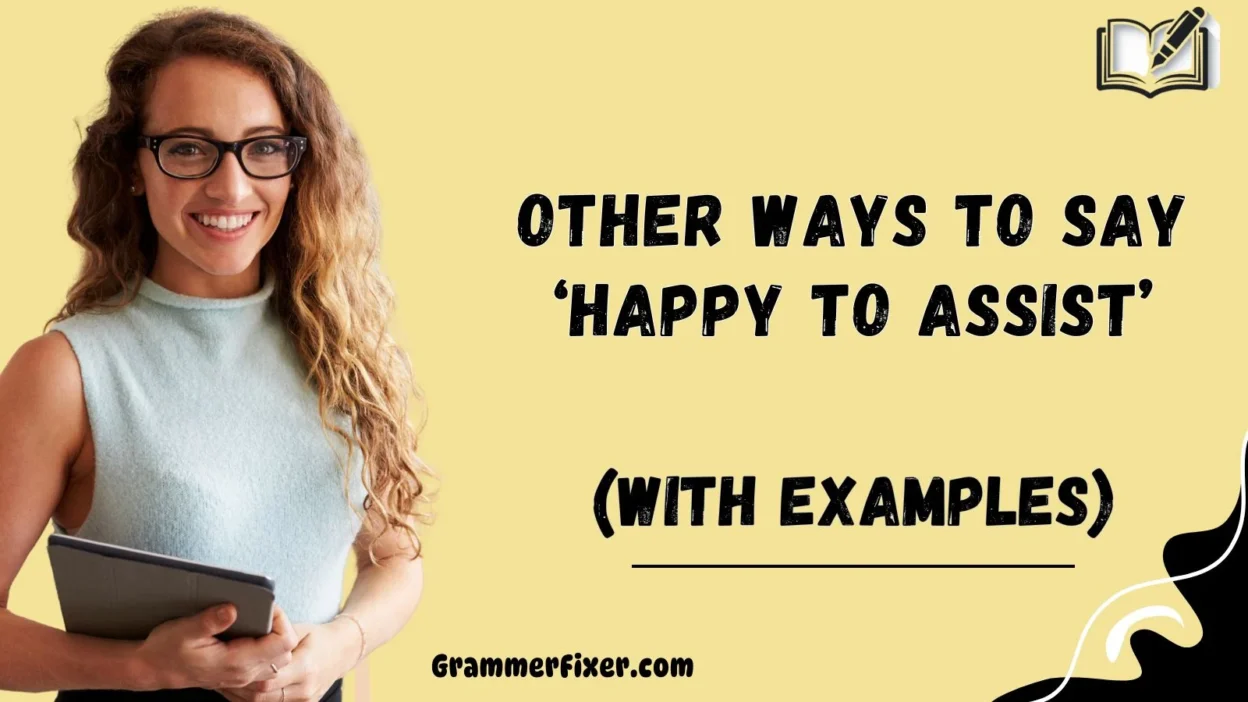Finding the right words to express care, support, and willingness to help can make a big difference in how your message is received. While “Happy to Assist” is a polite and professional phrase, there are many other ways to say the same thing that can feel warmer, more personal, or more tailored to the situation.
These alternatives not only add variety to your communication but also help you connect with others in a more empathetic and thoughtful way.
What Does “Happy to Assist” Mean?
The phrase “Happy to Assist” conveys willingness, readiness, and positivity when helping someone. It shows that you are not just performing a task but are genuinely glad to provide support.
When to Use “Happy to Assist”?
You can use “Happy to Assist” in professional emails, customer-service interactions, business correspondence, or personal conversations where you want to sound polite, approachable, and cooperative.
Is It Professional/Polite to Say “Happy to Assist”?
Yes, it’s considered both professional and polite. It works in formal, semi-formal, and customer-service settings. However, using it repeatedly may feel too standard or impersonal, which is why exploring alternatives is valuable.
Pros or Cons of Using “Happy to Assist”
Pros:
- Polite and professional
- Clear and friendly
- Universally understood
Cons:
- Can feel generic or repetitive
- Lacks personalization
- Sometimes sounds like an auto-response
1. Pleased to Help
Meaning: A classic and polite alternative that feels slightly more formal.
Detailed Explanation: This phrase communicates courtesy and a sense of professionalism while still being warm.
Scenario Example:
“I’m pleased to help with your request, Sarah. Please let me know if you need anything else.”
Best Use: Business emails, professional settings.
Worst Use: Very casual chats with close friends.
Tone: Formal, respectful, and professional.
2. Glad to Be of Service
Meaning: A traditional phrase that emphasizes your role in supporting someone.
Detailed Explanation: This conveys pride and satisfaction in being helpful.
Scenario Example:
“Glad to be of service, Tom. If any further issues come up, don’t hesitate to reach out.”
Best Use: Customer service replies, polite professional settings.
Worst Use: Casual texting.
Tone: Courteous, somewhat formal.
3. It’s My Pleasure
Meaning: A simple, warm, and direct response.
Detailed Explanation: Popular in hospitality and service industries, it communicates genuine enjoyment in helping.
Scenario Example:
“It’s my pleasure, Brian. Always here if you need anything.”
Best Use: Hospitality, customer interactions, friendly settings.
Worst Use: Overly serious or formal corporate contexts.
Tone: Friendly, warm, approachable.
4. No Problem
Meaning: An informal, quick response that downplays the effort.
Detailed Explanation: Shows that the request wasn’t a burden, making it perfect for casual settings.
Scenario Example:
“No problem, Tony. Glad I could help you get through that.”
Best Use: Texting, casual emails, chatting with colleagues.
Worst Use: Formal client-facing communication.
Tone: Relaxed, informal, conversational.
5. Anytime
Meaning: Communicates that you are always available to provide assistance.
Detailed Explanation: This highlights reliability and consistency.
Scenario Example:
“Anytime, Scott. You can always rely on me for support.”
Best Use: With colleagues, friendly professional exchanges.
Worst Use: Overly formal business communication.
Tone: Dependable, approachable, warm.
6. We’ve Got Your Back
Meaning: Emphasizes support and partnership.
Detailed Explanation: Often used in team or collaborative environments to signal solidarity.
Scenario Example:
“Don’t worry, Sarah. We’ve got your back on this project.”
Best Use: Teamwork, motivational settings.
Worst Use: Strictly formal communication.
Tone: Supportive, reassuring, collaborative.
7. That’s What I’m Here For
Meaning: A direct way of saying that assisting is part of your role.
Detailed Explanation: Conveys dedication and reliability without making it sound like an extra burden.
Scenario Example:
“Of course, Ewan. That’s what I’m here for.”
Best Use: Customer service, professional assistance roles.
Worst Use: Very formal or ceremonial contexts.
Tone: Dependable, approachable, supportive.
8. Thrilled I Could Help
Meaning: Expresses true enthusiasm and satisfaction in being helpful.
Detailed Explanation: Stronger than the original phrase, it shows genuine delight.
Scenario Example:
“Thrilled I could help you out with that, Joe!”
Best Use: Friendly client interactions, casual-professional emails.
Worst Use: Highly formal communication.
Tone: Enthusiastic, friendly, upbeat.
9. Delighted to Help
Meaning: A more formal yet warm variation of expressing helpfulness.
Detailed Explanation: Combines professional politeness with genuine warmth.
Scenario Example:
“Delighted to help, Ms. Copley. Please contact me if you have further queries.”
Best Use: Professional emails, polite client responses.
Worst Use: Very casual settings.
Tone: Professional, polished, gracious.
10. Let’s Find a Solution Together
Meaning: Highlights a collaborative approach to problem-solving.
Detailed Explanation: Invites the other person into a partnership dynamic.
Scenario Example:
“Let’s find a solution together, Roger. Two heads are better than one.”
Best Use: Team discussions, problem-solving contexts.
Worst Use: Quick one-off assistance.
Tone: Collaborative, inclusive, supportive.
11. I Appreciate You Reaching Out
Meaning: Acknowledges the customer’s initiative in seeking help.
Detailed Explanation: This phrase centers on the client’s experience, making them feel valued.
Scenario Example:
“I appreciate you reaching out, Summer Fox. Let me walk you through the next steps.”
Best Use: Customer service, business emails.
Worst Use: Casual conversations with friends.
Tone: Appreciative, professional, courteous.
12. Happy to Be of Service
Meaning: A classic, formal phrase used in business and service contexts.
Detailed Explanation: It conveys willingness and dedication while sounding polished.
Scenario Example:
“Happy to be of service, Mr. Bradley. Please let me know if you have additional questions.”
Best Use: Client communication, customer service.
Worst Use: Informal chats.
Tone: Formal, professional, dependable.
13. Always Happy to Help
Meaning: Reinforces ongoing willingness to provide assistance.
Detailed Explanation: This phrase emphasizes consistency, reliability, and availability.
Scenario Example:
“Always happy to help, Sarah. Don’t hesitate to ask again.”
Best Use: Friendly client emails, supportive work exchanges.
Worst Use: Ultra-formal situations.
Tone: Warm, reassuring, approachable.
14. Don’t Mention It
Meaning: A casual way of saying the help was no trouble at all.
Detailed Explanation: This phrase downplays the effort and avoids formality.
Scenario Example:
“Don’t mention it, Brian. I was glad to lend a hand.”
Best Use: Friendly or casual communication.
Worst Use: Business emails with clients.
Tone: Informal, relaxed, friendly.
15. Happy to Be of Assistance
Meaning: Similar to the original, but slightly more formal and polished.
Detailed Explanation: This adds a touch of professional refinement.
Scenario Example:
“Happy to be of assistance, Ms. Jolie. Please contact me again if needed.”
Best Use: Polite professional correspondence.
Worst Use: Casual interactions.
Tone: Professional, formal, courteous.
16. Count on Me
Meaning: Signals dependability and trustworthiness.
Detailed Explanation: This shows that you are someone the other person can rely on.
Scenario Example:
“Count on me, Gordon. I’ll make sure this gets handled quickly.”
Best Use: Team collaborations, peer support.
Worst Use: Very formal emails.
Tone: Reliable, supportive, approachable.
17. Happily Again
Meaning: Suggests you’re glad to help repeatedly.
Detailed Explanation: This shows ongoing availability and cheerful willingness.
Scenario Example:
“Happily again, dear client. Feel free to reach out whenever you require support.”
Best Use: Customer service, client follow-ups.
Worst Use: Casual one-time favors.
Tone: Consistent, dependable, friendly.
18. Let Me Know What Else You Need
Meaning: An open invitation to request further help.
Detailed Explanation: This phrase highlights proactive support and availability.
Scenario Example:
“Let me know what else you need, Tom Walters. I’ll be glad to assist further.”
Best Use: Professional emails, ongoing projects.
Worst Use: Casual texts.
Tone: Professional, proactive, supportive.
19. That’s Covered
Meaning: Implies the task is already taken care of.
Detailed Explanation: This phrase provides reassurance and demonstrates competence.
Scenario Example:
“That’s covered, Scott. You can trust that it will be delivered on time.”
Best Use: Workplace communication, project updates.
Worst Use: Casual chats with friends.
Tone: Confident, professional, reassuring.
20. Consider It Done
Meaning: A strong phrase that shows decisiveness and confidence.
Detailed Explanation: It conveys certainty and quick action.
Scenario Example:
“Consider it done, Isaiah. I’ll have it ready before tomorrow’s meeting.”
Best Use: Professional contexts where confidence matters.
Worst Use: Overly formal corporate replies.
Tone: Decisive, confident, action-oriented.
21. All Through and Covered
Meaning: Suggests completion and reliability.
Detailed Explanation: This phrase reassures the other person that the issue is fully resolved.
Scenario Example:
“All through and covered, Ms. Kingsley. You can rest easy now.”
Best Use: Project completion updates.
Worst Use: Everyday casual conversations.
Tone: Reassuring, professional, complete.
22. Of Course
Meaning: A polite, natural response showing that helping was expected.
Detailed Explanation: Communicates ease and approachability.
Scenario Example:
“Of course, Roger Smith. I was glad to help with your query.”
Best Use: Polite casual or professional responses.
Worst Use: Highly formal contexts.
Tone: Warm, approachable, courteous.
23. Anything for You
Meaning: Expresses dedication and commitment to someone’s needs.
Detailed Explanation: Works best when you want to highlight personal connection.
Scenario Example:
“Anything for you, dear colleague. You can trust me to get it done.”
Best Use: Close professional or personal relationships.
Worst Use: Strictly formal business contexts.
Tone: Personal, warm, supportive.
24. With Pleasure
Meaning: A formal yet warm alternative similar to “It’s my pleasure.”
Detailed Explanation: Communicates grace and satisfaction in being helpful.
Scenario Example:
“With pleasure, Sarah Copley. Always here to provide support.”
Best Use: Professional and formal correspondence.
Worst Use: Casual texting.
Tone: Polished, gracious, professional.
25. At Your Service
Meaning: A classic and formal way of expressing readiness to help.
Detailed Explanation: Often used in hospitality or service industries, it conveys dedication.
Scenario Example:
“At your service, Ms. Walters. Please reach out for anything further.”
Best Use: Hospitality, client care.
Worst Use: Everyday informal conversations.
Tone: Formal, polite, dependable.
26. Glad I Could Help
Meaning: A friendly and conversational variation.
Detailed Explanation: It shows humble appreciation and genuine willingness.
Scenario Example:
“Glad I could help, Tom. Best wishes moving forward.”
Best Use: Emails, casual workplace interactions.
Worst Use: Overly formal client settings.
Tone: Friendly, approachable, warm.
27. Always Here If You Need Me
Meaning: Expresses ongoing availability and reliability.
Detailed Explanation: It’s a reassuring phrase for colleagues, clients, or friends.
Scenario Example:
“Always here if you need me, Ewan. Don’t hesitate to ask.”
Best Use: Supportive professional or personal conversations.
Worst Use: One-off customer service interactions.
Tone: Reassuring, dependable, supportive.
28. I’ll Handle It
Meaning: Signals confidence and initiative.
Detailed Explanation: It communicates leadership and decisiveness.
Scenario Example:
“I’ll handle it, Brian. You can focus on your part of the project.”
Best Use: Team environments, leadership roles.
Worst Use: Hospitality or customer service contexts.
Tone: Decisive, confident, assertive.
29. Not a Trouble at All
Meaning: A polite phrase that minimizes the effort taken.
Detailed Explanation: Makes the other person feel they were not a burden.
Scenario Example:
“Not a trouble at all, Sarah. It was a pleasure helping.”
Best Use: Polite casual or professional emails.
Worst Use: Ultra-formal contexts.
Tone: Friendly, polite, reassuring.
30. You’re Welcome
Meaning: The most common, timeless response to gratitude.
Detailed Explanation: Simple and universally understood, though less expressive.
Scenario Example:
“You’re welcome, Joe. Always happy to assist.”
Best Use: Any context, professional or personal.
Worst Use: None (universally acceptable).
Tone: Neutral, polite, timeless.
Conclusion
Finding other ways to say “Happy to Assist” allows you to communicate warmth, professionalism, and reliability in a way that fits the context and audience. Each alternative carries a slightly different tone — some are formal and polished like “With Pleasure” or “At Your Service,” while others are friendly and casual like “No Problem” or “Anytime.”
Using these phrases thoughtfully helps you personalize your messages, show genuine willingness, and strengthen connections with clients, colleagues, or friends. By selecting the right wording, you convey approachability, dependability, and empathy, making your communication not only clear but also memorable and impactful.



